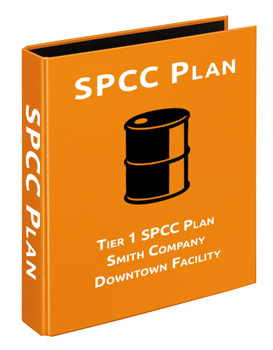We explain what a SPCC Plan is, and whether or not your facility may need one.
Whether you're in Juneau, Alaska, or Baton Rouge, Louisiana, chances are you have some type of oil or petroleum product at your facility. Depending on what you do, the size of your facility, and the activities you perform there, you might have a little, or you might have a lot. When we visit a site, or talk to personnel on the phone, and learn they have a lot of oil or petroleum, we'll ask if they have an SPCC, or Spill Prevention, Control and Countermeasure Plan, to which we usually hear: What's a SPCC Plan?
I hate to hear it! But, I understand why so many folks are in the dark about SPCC Plans (which I'll explain below). Honestly, I hear it a lot, and from everyone, from new hires to seasoned managers.
So let's shine some light on the subject and get into it.
SPCC Plans & SPCC Regulations
Let's get one thing clear right now. This is not an SWPPP Plan. That's short for Stormwater Pollution Prevention Plan. They are not the same. They are not interchangeable. Having one does not cover the other. Ok?
SPCC stands for Spill Prevention, Control and Countermeasure. Often times we'll hear "spill plan" or "oil spill plan", or something along those lines. It's ok to call it that if you'd like, but you'll probably end up confusing yourself or your staff.
These plans are required by Federal law under the Oil Pollution Prevention regulations (40 CFR 112 if you're really interested). Briefly, it states that any "non-transportation facility", with the "potential to discharge oil to waters of the U.S.", and who stores oil or petroleum products on-site in excess of 1,320 gallons, needs to prepare and implement a plan meeting the requirements and intent of the regulation.

There're a few key things in there which we need to break down:
- Non-transportation facility - Means your facility is stationary, but really, it covers almost all facilities, including industrial, commercial, agricultural or public facilities that store, produce or use oil or oil products. For most facilities, you can ignore this part.
- Potential to discharge oil to waters of the U.S. - Guess what? That creek a mile away from you fits the criteria. That wetlands across the highway...that does too. And, that catch basin down the road likely leads to some sort of water-body. Point is, you definitely have the potential to discharge oil to waters of the U.S., even if it's not close. Again, largely ignore this point, because the EPA will figure out how you "could" discharge.

- Stores oil or petroleum products on-site in excess of 1,320 gallons - This is a bit trickier, and where you need to pay attention. You have to have the capacity to store over 1,320 gallons on site. Meaning, if you have a tank that could hold 1,000 gallons, but is only ever kept half full, it's considered full with 1,000 gallons by the EPA. They regulate any container that is sized 55-gallons and up. So if you have eight 55-gallon tanks of various oils and a 500-gallon heating oil tank, and a 500-gallon gasoline tank, then you need a plan. Just remember containers 55-gallons and larger only. The vast majority of facilities we visit need a plan. But fortunately, there are different kinds, which we'll link to below.
- Underground tanks - While I didn't include them in the above paraphrase of the regulations, there is a threshold for underground storage tanks to trigger the need for a plan, but it's 42,000 gallons, a fairly high amount. However, if you trigger the need with above ground tanks, then you'll have to include your underground tanks, and vice versa.
- Oil or petroleum - You need to consider all your oil and petroleum products. Used oil, waste oil (and there is a difference), bio-oils, biofuels, gasoline, diesel, hydraulic oil, motor oil, lubricating oil, etc., etc. You do not have to include diesel exhaust fluid, or antifreeze. The only reason I say that is I see a lot of poorly made plans which include those items. Don't include them, you do not have to.
- Implement a plan meeting the requirements and intent of the regulation - This is basically saying your plan has to adhere to the regulations and address the requirements of the law. Simply put, you can’t just wing it and make something up.
To wrap regulations up, just know there is no permit or approval necessary here. You don’t have to give anyone a copy of your plan for any type of review or approval. You simply figure out you need one, get one developed, and start using it.
What is a SPCC Plan?
Usually, it's a notebook-type document, which you'll keep handy at your facility. The ones we prepare usually look like this:

There are 3 types of plans which are dependent on the amount of oil you store, any spill history you have at your site, and the size of your storage containers. They are:
- Tier I SPCC Plans - For facilities with less than 10,000-gallons of oil and petroleum on-site.
From our experience, any plan which is credible and can even closely conform to the regulations is usually between 15 and 100 pages. A simple, smaller facility will have a smaller plan, and a larger, more complex operation will have a larger plan. Makes sense, right?
Just be warned, and I say this because we've seen it dozens and dozens of times, but anyone who gives you a 1 or 2 page document, and tries to convince you that's your plan and it's all you need, doesn't know what they're doing. If I was you I'd get your money back.

Basic Components of a SPCC Plan
Here's an overview of the plan, and what you'll likely find in it:
- Basic facility information - Things like the owner, the location, a description of the operation, the proximity and release pathway to waters of the U.S., contact information, etc.
- Oil & petroleum information - You'll find a detailed identification of tanks, their locations, their contents, storage capacity, secondary containment details, etc.
- Emergency information - Things like police department numbers, emergency responders numbers, hospital locations & phone numbers, EPA spill hotline numbers, your state's environmental agency phone numbers, clean-up contractors, critical staff phone numbers, etc. Normally you'll see information as well on how to act in case of a small spill, including actions to perform to slow or stop the release.
- Fueling & filling procedure information - You'll find a section outlining where and when fueling occurs, who does it, security protocols, etc., including procedures for outside contractors who come into your facility to fill or fuel from tanks.
- Current facility information for preventing spills - Are the tanks contained (more about this later)? Are all the fill ports, fuel pumps, etc. locked? Is there spill control equipment and materials readily available? What form of site security is present to safeguard against vandalism? What kind of training occurs to ensure that all facility personnel who handle petroleum in any way understand how to prevent spills and leaks? What training occurs to ensure that all facility personnel know what to do in the event of a spill or leak discharge emergency?
- Inadequacies in the current spill prevention program & how to fix them - What areas dealing with spill prevention and containment are determined to be inadequate at present, and what improvements need to be made and when? For example, if you don't have adequate sized secondary containment for all ASTs, when will it be installed, and of what size? Do you have adequate signage posted on and near storage tanks for identification and safety purposes? Are you conducting inspections? Stuff like that.

- Inspection information - You'll find a discussion of a comprehensive inspection program, to include monthly AST inspections (of all tanks, areas around tanks, fuel and fill lines, all piping, secondary containment areas, potential discharge areas, etc.) as well as a comprehensive annual inspection (including all of the above, as well as additional aspects such as confirmation of training, review of records and other documentation, etc.).
- Regular review & training - You'll need to regularly review the plan and make sure it's up to date. If you move a tank, or get rid of one, or increase your capacity, you'll need to revise your document. Depending on the revisions, sometimes it's necessary to have a professional engineer certify the plan. Additionally, you'll need, at the very least, annual training for your staff who handles oil or petroleum in any way. It's required, and you'll have to keep records of who gets trained, when they get trained, and what they get trained on.
- Other associated documents - Things like how to release water contained within secondary containment (you absolutely do not just open the valve and let it flow out!), other various inspection notes, additional documents related to preventing accidents, etc.
- A section to say "we can't do this" - If for some reason you can't conform to the regulations, you need to explain why. Also, you need to describe how alternative means have been implemented to meet the intent of the regulations (but don't count on this as an easy out from the SPCC requirements).

It's a lot. Sometimes this information can be summed up quickly, and other times it drags on over the course of 100+ pages. It all depends on your facility, your storage capacity, and your spill history.
When I said "are the tanks contained?", that's because part of the regulations require that tanks be kept inside of secondary containment. A double-walled tank counts, or a concrete vault type tank counts, or a tank sitting inside appropriately sized, waterproof containment all count as secondary containment.
Appropriately sized generally means the storage area holding the tank can accommodate 110% of the tank's contents (although this requirement has changed a bit for technical reasons, and may in some cases require more than 110%). So, if you have a 1,000-gallon tank inside a storage area made of concrete block walls, sitting on a sealed, solid concrete floor, then that storage area usually should be able to hold 1,100-gallons of whatever's in that tank.

SPCC Plans Can Be Complex
As you can see, they can be pretty detailed, very thorough, and comprehensive documents. See why I said 1 or 2 pages doesn't cut it?
You might be thinking, I've never been asked about this, what gives? Well, since this regulation is enforced by the EPA, and you may have never been inspected by them before, you may have never heard of it. We hear this a lot, and it makes a lot of sense.
If no one is enforcing the rules, and the rules aren't clear, then it's understandable that you've never heard of this regulation before. Fortunately, the EPA agrees sometimes, and if you're caught without one, they may go easy on you. However, if you're caught without one and have a spill, you're in for a world of trouble.
What's the real point of this? Given that there's no permit or approval, no government costs involved, and no one will review and approve your plan, the costs are limited only to the costs of SPCC development and any costs associated with improvements or updates needed at your facility. So you can't say this is another "government fee-generator" type thing.
Instead, the real point is to help YOU prevent oil spills at your facility, from accidents, equipment malfunction, vandalism, or more. Given the extremely high costs you'd incur if you did have a spill or discharge at your facility, it seems to be some of the best insurance you could possibly have.
And, at the end of the day, it keeps oil and petroleum away from our nation's waterways. There's no one who can argue with keeping them clear and clean.
And lastly, it helps keep you and your employees safe in an emergency.

Here are some additional resources you may find helpful regarding SPCC information:
Do you need a plan at your facility? If you do, get one ASAP. To learn more, click here to contact us or give us a call at 609-693-8301 to discuss your environmental needs today.


















